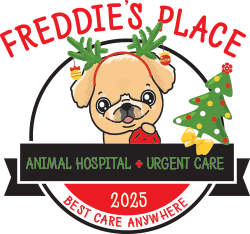A #FreddieSez Investigative Report
Of all the dirty words in canine healthcare, Parvo is among the worst of… and the saddest part is that it is completely avoidable in almost every case. In this week’s Dog Blog, we will examine the symptoms, treatments, suggested vaccine regiment, which dogs are most at risk, and other key points to help you avoid, recognize, and treat parvovirus.
Fast Facts
Here are some quick read facts about the virus that all dog owners should know…
What is Parvovirus?
Parvo is a highly contagious gastrointestinal illness that is mostly diagnosed in puppies and young dogs. However, parvo is an equal opportunity infection disease and infects dogs of all ages who are exposed and not vaccinated. What makes parovirus so dangerous is its ability to spread quickly, and it’s fast moving effects once it has entered a dogs system. A puppy can go from their loving and playful selves to fatally ill in a matter of days. Once exposed, a dog is a carrier of the virus and can spread it to other animals in as little of four to five days after infection. Because of its long lasting nature, a canine can still spread the illness up to 10 days after they have recovered. This fact alone is why any dog who shows signs of parvo, or has tested positive as being infected by the virus, should be quarantined immediately to protect other animals.
How is Parvo Spread?
There is no one single way that the virus moves from dog to dog… in fact, because it is spread through direct and indirect contact, it is hard to stop the spread once you or your pet have come in contact with the virus. Something as innocent as a walk in the park could expose your dog to the virus, as it lives on grassy surfaces, as well as fur, in feces, shared water or food sources, and on a humans hands/clothing. Common playthings like toys, ropes, blankets, or balls can carry the virus. A pregnant dog can pass parvovius through her milk, through grooming, or through fur to fur contact.
The more alarming fact is that once it is in your home, it is everywhere. It is nearly impossible to rid your home and yard from the virus once its been introduced. The chemical treatments that will kill the virus will also kill your grass and plants, ruin your carpets and furniture, stain or eat away at your clothing… and there is no real guarantee that you’ve gotten all areas where the virus lives.
How Can I Keep my Dog Safe?
There is no 100% way to keep your dog clear of parvo. However, if you take preventative steps when they are new puppies, the chances are reduced dramatically. Most veterinarians recommend a series of three shots for parvovirus prevention, one at 6 to 8 weeks old, another at 10 to 12 weeks old, and the last at 14 to 16 weeks. Since a newborn pup inherits its Mothers immunity protection for a short time after birth, this allows time for growth before the first shot is needed. After the initial round of three shots, it is important that your dog receives a booster shot 1 year later, then every three years after.
As a precaution, unvaccinated puppies should not be exposed to unvaccinated adult dogs… the opposite is also true. However, fully vaccinated older dogs are safe to visit the puppy. In fact, socialization of the puppy is key to their advancement and growth, so these interactions are important for learning. An unvaccinated puppy should never be allowed in a daycare, training classes, or play groups. Vaccines work wonders in prevention, but they cannot prevent the virus from spreading to all dogs, all the time. However, they do severely limit the impact, effects, and improve survival rates.
What are the Visible Symptoms of Parvo?
Once infected, your dog will start to show symptoms of the virus in as little as 3 days, or as long as 10 days. The symptoms will likely be aggressive, fast moving, and alarming to pet parents. The visible clues to parvovirus are normally easy to detect in puppies but are often hidden in adult dogs and they may not seem sick at all, if ever. The adult dog immune systems is more robust and has a better chance at fighting off the virus, especially if they are fully vaccinated and boosted. Here are the most common signs of parvovirus in puppies…
If you notice any of these symptoms, it should be cause enough to take your dog to a veterinarian. Even if its not parvovirus, these are telltale signs of a major health concern. Because intestinal parvo attacks the stomach and intestines, blood leaking is common. This can lead to a variety of other illnesses, such as anemia, and a drop in white blood cells. If you see symptoms, your puppy could have a potential fatal condition and needs to be diagnosed and treated. The mortality rate for dogs who are unvaccinated and contract the parvovirus is 90%.
What is the Treatment for a Puppy Who is Diagnosed with Parvo?
Let’s be 100% clear, there is no cure for parvovirus. Any treatment your veterinarian recommends will be based on the symptoms the dog is showing.
- Normally the first thing that veterinarians will attack is the dehydration from the loss of fluid and minimal in take of food and water. Your puppy might be given IV fluids, or a “sub-q” injection that allows a shot of IV type fluid to slowly be absorbed through the skin.
- They could be given anti-diarrhea medication and mediation to stop the vomiting.
- To combat the lower white blood cells, and the attack on the immune system, the dog could be given antibiotics to fight the risk of infections.
- Your vet could ask you to hospitalize the animal for observation and ongoing treatment you could not provide at home. Recovery time for a parvovirus case is normally 7-10 days, but the possible survival rate is improved to 70 to 90% with this sort of commitment to recovery. However, the cost is very high, so leaving a puppy for hospitalization it is often not something families can afford.
Can my Dog Get Parvo Multiple Times?
Where it is very, very rare, the short answer is “Yes”. However, through treatments, medications given, and the natural healing process from the first battle with parvovirus, most dogs will never contract the virus again. After your dog has fully recovered from parvo, it is advisable to get them vaccinated within the following two week period.
Could I get the Parvovirus from my Dog?
It’s actually an odd situation. YOU can carry parvo to your dog simply by petting a dog who already has the virus, having an infected dog rub against your clothing, on a play date where the virus is present, or by taking them on a walk in the park… but your dog cannot pass the parvovirus to their parents or any other human.
In Conclusion
So how do you keep your dog from contracting parvovirus? The answer is that it’s on YOU, the owner. It starts at the beginning, selecting your puppy. Parvo can run wild in a puppy mill, and the operators of the mill can be well aware. However, since the virus does not show itself until the mothers immunity has worn off the puppy, you could have a dog that is seemingly normal, until its not.
Be diligent on the place you decide purchase or rescue your puppy. Does the facility pass the “smell” test? Are they willing to let you see where the puppies live? Do the older dogs look socialized, fit, and happy? If you wait to get your puppy until they are 8-12 weeks old, you need proof of the initial vaccination for parvovirus. If they cannot produce this, or if the dog has not been vaccinated… it may not be a wise transaction to continue.
Once you have that puppy, be sure you follow the simple rules of “no socialization with unvaccinated dogs” until your dog has their initial first three shots. It might be uncomfortable asking someone if their dog has been vaccinated, especially in today’s hypertensive world. Is it any less uncomfortable than rushing your dog to the veterinarian and watch them struggle for life because you could ask?
If you take all the precautions, follow the vaccination requirements, watch for signs of parvo in other dogs you might encounter, and keep your puppy safe, it’s still not 100% that your dog will never have parvovirus. The great news is that IF you’ve done all the up front work, there is a 70-90% chance that, even if they are among the rare vaccinated and protected who catch parvo, they get to come back home to you and live long and full lives. Isn’t that a risk you’re willing to take?
This has not been he most fun and enjoyable Dog Blog we’ve ever written, but is its among the most informative and important. We certainly hope you’ve found some benefit in your time spend reading the information we’ve provided and take it to heart. The love of a dog is precious and special, we feel like humans often take dogs for granted… until they’re gone from our lives. Never live with a case of the “what if” or “should I have” when you could simply be the person that your dog already thinks you are.
That’s all from FreddieSez Central for this week. We will let you know that as we turn the page on July, it’s DOGgust in August at Freddie’s Fun Place, our “for fun” social media site where we look at the lighter side of pet ownership. Freddie’s Fun Place is on Facebook and Instagram… we’d love for you to drop by to enjoy a different side of Freddie! Look us up, won’t you?
We also have a great DOGgust special for senior pets at Freddie’s Place Animal Hospital + Urgent Care, where all pets who are 7 years or older will get 20% off an exam & senior complete panel. It’s just part of the Freddie’s Place commitment to providing the Best Care Anywhere at the always fair “Freddie Friendly Price”. Learn more at www.freddiesplaceanimalhospital.com
Till we meet again next week for another lesson in our Freddie sessions, please take a moment to hug your pets and hold them tight, let them sleep with you during the night, if you’re eating sneak them a quick bite, take the time to treat them right… and always be Pet Friendly, #FreddieSez!
Blog Research Sites




Leave A Comment